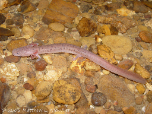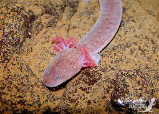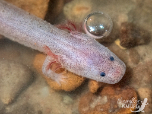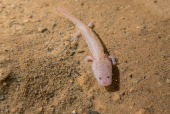Tennessee Cave Salamander (Gyrinophilus palleucus)
Description: A large salamander (4.0 to 7.5 inches in length) with small eyes, lack of eyelids, wide head, spatulate snout, and bright red feathery, external gills. Overall coloration is salmon to pale pink with a pale belly. G. p. necturoides is dark and heavily spotted and G. p. palleucus is pale flesh-pink in color.
Habitat: It occurs on sand, gravel, mud or rock, in streams, in rimstone pools and in isolated pools. It prefers clear water without sediment. It is occasionally seen outside caves but it is thought that this occurs when it has been accidentally washed out by floodwater.
Range: The Tennessee cave salamander inhabits the southern Cumberland Plateau in the Appalachian Mountains. Its range includes south-central Tennessee, western North Carolina, northeastern Alabama, northwestern Alabama and northwestern Georgia. The salamander lives in cave systems, and is probably present in some systems as yet unexplored.
Found in these States:
AL |
GA |
TN
Diet: The salamander's diet consists of amphipods and other small aquatic invertebrates that live in caves.
Reproduction: Very little known. Most Tennessee Cave Salamanders spend their lives in the larval stage; hence they do not migrate out of the cave environment. Females lay eggs in fall or early winter based upon sightings of small hatchlings in winter. Egg laying is suspected to be similar to Spring Salamanders, which occurs under large rocks.
Status: Listed as Near Threatened because its extent of occurrence (EOO) is 28,152 km2, it occurs in 10 or fewer threat-defined locations, and there is continuing decline in the extent and quality of its habitat, thus making the species close to qualifying for Vulnerable.
»» Kingdom: Animalia - Animals
»» Phylum: Chordata - Chordates
»» Subphylum: Vertebrata - Vertebrates
»» Class: Amphibia - (Amphibians)
»» Order: Caudata - Salamanders
»» Family: Plethodontidae - Lungless Salamanders
»» Genus: Gyrinophilus
»» Species: Gyrinophilus palleucus - Tennessee Cave Salamander
This article uses material from the Wikipedia article "Tennessee Cave Salamander", which is released under the Creative Commons Attribution-Share-Alike License 3.0. Content may have been omitted from the original, but no content has been changed or extended.
|













